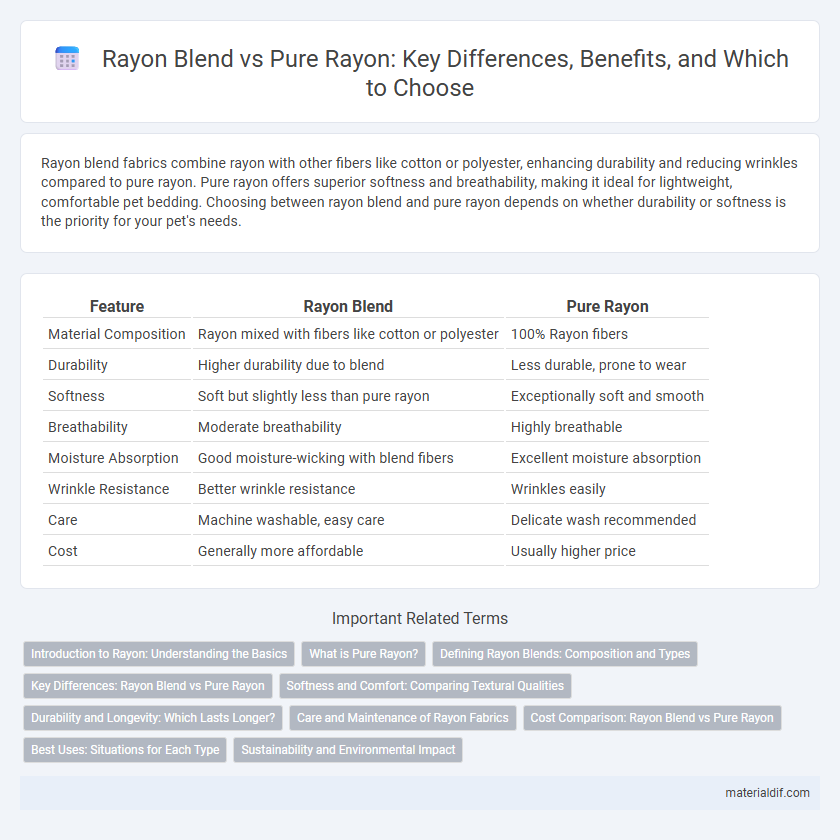Rayon blend fabrics combine rayon with other fibers like cotton or polyester, enhancing durability and reducing wrinkles compared to pure rayon. Pure rayon offers superior softness and breathability, making it ideal for lightweight, comfortable pet bedding. Choosing between rayon blend and pure rayon depends on whether durability or softness is the priority for your pet's needs.
Table of Comparison
| Feature | Rayon Blend | Pure Rayon |
|---|---|---|
| Material Composition | Rayon mixed with fibers like cotton or polyester | 100% Rayon fibers |
| Durability | Higher durability due to blend | Less durable, prone to wear |
| Softness | Soft but slightly less than pure rayon | Exceptionally soft and smooth |
| Breathability | Moderate breathability | Highly breathable |
| Moisture Absorption | Good moisture-wicking with blend fibers | Excellent moisture absorption |
| Wrinkle Resistance | Better wrinkle resistance | Wrinkles easily |
| Care | Machine washable, easy care | Delicate wash recommended |
| Cost | Generally more affordable | Usually higher price |
Introduction to Rayon: Understanding the Basics
Rayon is a semi-synthetic fiber made from regenerated cellulose, offering a soft and breathable fabric often used in apparel and textiles. Rayon blends combine rayon with other fibers like cotton or polyester, enhancing durability, wrinkle resistance, and stretch compared to pure rayon, which is known for its smooth texture and excellent drape but can be prone to shrinking and wrinkling. Understanding these differences helps consumers choose the ideal fabric based on comfort, care, and intended use.
What is Pure Rayon?
Pure rayon is a semi-synthetic fiber made from 100% natural cellulose derived from wood pulp, without any blends or additives. It offers a smooth, silky texture and excellent breathability, making it popular for lightweight clothing and home textiles. Unlike rayon blends, pure rayon provides consistent softness, drape, and moisture absorption, enhancing comfort and durability.
Defining Rayon Blends: Composition and Types
Rayon blends combine pure rayon fibers with other materials such as cotton, polyester, or spandex to enhance durability, stretch, and texture. Common types include rayon-polyester blends, offering improved wrinkle resistance, and rayon-spandex blends, which provide elasticity and comfort. These compositions optimize fabric performance while maintaining the soft, breathable characteristics of pure rayon.
Key Differences: Rayon Blend vs Pure Rayon
Rayon blend fabrics combine rayon with other fibers such as polyester, cotton, or spandex, enhancing durability, stretch, and wrinkle resistance compared to pure rayon. Pure rayon, made solely from regenerated cellulose fibers, offers superior breathability and softness but tends to wrinkle easily and requires more delicate care. The choice between rayon blend and pure rayon depends on desired fabric performance, with blends providing greater strength and versatility while pure rayon emphasizes natural feel and comfort.
Softness and Comfort: Comparing Textural Qualities
Rayon blend fabrics combine the smooth, silky texture of pure rayon with the added durability and stretch of other fibers, resulting in enhanced softness and greater comfort for everyday wear. Pure rayon is renowned for its exceptional breathability and fluid drape, making it luxuriously soft against the skin but sometimes less resilient to wear and washing. Blended rayon fabrics balance the natural softness with improved strength and wrinkle resistance, offering a comfortable, easy-care solution suitable for a variety of garments.
Durability and Longevity: Which Lasts Longer?
Rayon blends generally offer greater durability and longevity compared to pure rayon due to the incorporation of stronger fibers like polyester or cotton, which enhance fabric strength and resistance to wear. Pure rayon tends to be more delicate, prone to shrinking, and loses shape with frequent washing, reducing its lifespan. Fabrics with higher synthetic fiber content in the blend exhibit improved wrinkle resistance and overall durability, making them more suitable for long-term use.
Care and Maintenance of Rayon Fabrics
Rayon blend fabrics generally offer enhanced durability and easier care compared to pure rayon, which tends to be more delicate and prone to shrinking or wrinkling. Washing rayon blends often requires gentle machine cycles or hand washing with cold water, while pure rayon demands more meticulous hand washing and air drying to maintain fabric integrity. Proper care for both includes avoiding high heat during drying and ironing to prevent damage and preserve the soft texture characteristic of rayon fibers.
Cost Comparison: Rayon Blend vs Pure Rayon
Rayon blend fabrics typically cost less than pure rayon due to the inclusion of synthetic fibers that reduce overall material expenses and enhance durability. Pure rayon, made solely from regenerated cellulose fibers, demands higher production costs for its fine texture and breathability. Manufacturers balance price and quality by opting for blends, offering affordable options without compromising the softness and drape characteristic of pure rayon.
Best Uses: Situations for Each Type
Rayon blend fabrics, combining rayon with fibers like cotton or polyester, offer enhanced durability and wrinkle resistance, making them ideal for everyday apparel such as casual dresses and shirts. Pure rayon, known for its breathability and silky texture, excels in formal wear and summer clothing where softness and moisture absorption are prioritized. Choosing between rayon blend and pure rayon depends on the need for longevity and ease of care versus a luxurious feel and natural drape.
Sustainability and Environmental Impact
Rayon blend fabrics combine natural cellulose fibers with synthetic materials, often reducing biodegradability and increasing ecological footprint compared to pure rayon made solely from regenerated cellulose. Pure rayon, derived from sustainable sources like bamboo or eucalyptus, tends to have a lower environmental impact due to its biodegradability and reduced reliance on petrochemicals. However, the production process of rayon, including chemical use and water consumption, remains a critical factor in evaluating overall sustainability regardless of blend composition.
Rayon Blend vs Pure Rayon Infographic

 materialdif.com
materialdif.com